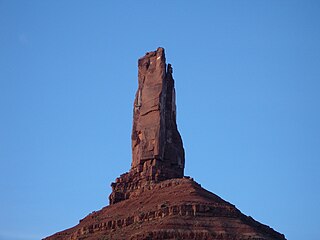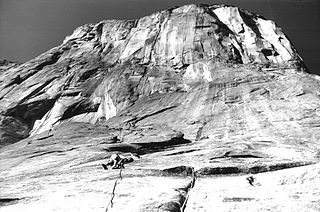
Mount Edith Cavell is a mountain located in the Athabasca River and Astoria River valleys of Jasper National Park, and the most prominent peak entirely within Alberta.

Grand Teton is the highest mountain in Grand Teton National Park, in Northwest Wyoming, and a classic destination in American mountaineering.

Crestone Needle is a high mountain summit of the Crestones in the Sangre de Cristo Range of the Rocky Mountains of North America. The 14,203-foot (4,329 m) fourteener is located 6.9 miles (11.1 km) east-southeast of the Town of Crestone in Saguache County, Colorado, United States. The Crestones are a cluster of high summits in the Sangre de Cristo Range, comprising Crestone Peak, Crestone Needle, Kit Carson Peak, Challenger Point, Humboldt Peak, and Columbia Point. They are usually accessed from common trailheads.

Fifty Classic Climbs Of North America is a climbing guidebook and history written by Steve Roper and Allen Steck. It is considered a classic piece of climbing literature, known to many climbers as simply "The Book", and has served as an inspiration for more recent climbing books, such as Mark Kroese's Fifty Favorite Climbs. Though much of the book's contents are now out of date, it is still recognized as a definitive text which goes beyond the traditional guidebook.

The Kor-Ingalls Route is a traditional rock climbing route located on Castleton Tower. Castleton Tower sits in Castle Valley North-East of Moab, Utah. The Route is recognized in the historic climbing text Fifty Classic Climbs of North America and considered a classic around the world.

The Salathé Wall is one of the original technical climbing routes up El Capitan, a 3,000-foot (900 m) high granite monolith in Yosemite National Park. The Salathé Wall was named by Yvon Chouinard in honor of John Salathé, a pioneer of rock climbing in Yosemite. The route is recognized in the historic climbing text Fifty Classic Climbs of North America and considered a classic around the world.

Petit Grepon is a semi-detached spire in Colorado's Rocky Mountain National Park. It is one of the "Cathedral Spires" which also includes Sharkstooth, The Saber, and The Foil. The South Face route of Petit Grepon is recognized in the historic climbing text Fifty Classic Climbs of North America and considered a classic around the world.
The South Face of Petit Grepon is a popular technical climbing route on the Petit Grepon in Colorado's Rocky Mountain National Park. The South Face is recognized in the historic climbing text Fifty Classic Climbs of North America and considered a classic around the world.

The Northcutt-Carter Route is a popular technical climbing route on Hallett Peak in Colorado's Rocky Mountain National Park. The Northcutt-Carter Route is recognized in the historic climbing text Fifty Classic Climbs of North America.

The Ellingwood Arete is a popular technical climbing route on Crestone Needle in Colorado's Sangre de Cristo Range. The Ellingwood Ledges Route is recognized in the historic climbing text Fifty Classic Climbs of North America. An "arete" is "a sharp narrow ridge found in rugged mountains".

The Middle Cathedral Rock is a prominent rock face on the south side of Yosemite Valley, California. El Capitan lies due north of Middle Cathedral. Middle Cathedral's East Buttress Route is recognized in the historic climbing text Fifty Classic Climbs of North America.

The East Buttress Route is a technical climbing routes up Middle Cathedral Rock. The route is recognized in the historic climbing text Fifty Classic Climbs of North America and considered a classic around the world.

The Steck-Salathé Route is a technical climbing route up Sentinel Rock. The route was first climbed June 30 - July 4, 1950, by Allen Steck and John Salathé, up the 1,600-foot (490 m) north face of Sentinel Rock in Yosemite Valley.

The North Face of Fairview Dome also known as the Regular Route of Fairview Dome is a technical rock climbing route in Tuolumne Meadows of Yosemite National Park. It is featured in Fifty Classic Climbs of North America.
The north face of the Grand Teton is a technical rock climbing in Wyoming. Today the route is usually climbed by a variation that avoids the chimneys which are often wet or icy. The route is recognized in the historic climbing text Fifty Classic Climbs of North America and considered a classic around the world.
The Direct South Buttress of Mount Moran is a technical rock climbing route on Mount Moran part of the Teton Range in Grand Teton National Park. The route is featured in Fifty Classic Climbs of North America.
The Northeast Face of Pingora is a technical rock climbing route on the Wolf's Head part of the Cirque of the Towers. The route is featured in Fifty Classic Climbs of North America.

Wolfs Head is a mountain located in the southern Wind River Range in the U.S. state of Wyoming. Wolfs Head is on the northwest side of the Cirque of the Towers, a popular climbing area. The peak is just north of Overhanging Tower and connected to Pingora Peak by a narrow arête. The East Ridge route on the Wolf's Head is recognized in the historic climbing text Fifty Classic Climbs of North America and considered a classic climb. Wolfs Head is situated on the Continental Divide.















